Sir Raymond’s Japan Tour 2018
Sir Raymond Winters Thanks The Members of EOS – Japan 2018
EOS Expo 2018, Japan
Sir Raymond visits shrine in Nagatacho, Tokyo Japan, as well as EOS headquarters.
Manoir d’Inno Tokyo, Japan.
Here at Sir Jason Winters International, we make no secret about the potential healthful benefits of tea. Tea is filled with antioxidants such as flavonoids which can help to promote overall good health. One of the beneficial components of tea, which comes from the plant Camellia sinensis, is tannin.
Tannins are compounds that are commonly found within green plants and can be found in a number of foods including wine and tea. Tannins are polyphenols that create the dry, astringent feeling that makes you want to pucker your lips after eating or drinking.
Darker teas tend to contain higher levels of tannins than green or white tea. The oxidation within black tea causes these higher levels of tannins. Heavy teas like lapsang souchong have high levels of tannins, where green teas have fewer.
Tannins cover a wide variety of compounds and are found in a number of foods, including most nuts, strawberries, and coffee. In nature, these compounds make plants taste bad to predators so they’ll survive longer.
Some people are skeptical about the benefits of tannins. After all, we get the name because these compounds were first used to tan leather. However, those tannins are highly concentrated, far more than you’d ever get in a tea or most foods. Few people soak acorns to get rid of the tannins before making acorn flour these days. And most foods high in tannins are too astringent to eat straight without processing. Thus, it’s hard to overdose on them.
Tannins can help to activate thrombocytes which can act to stop the flow of bleeding in minor injuries and can also help relieve pain and reduce bruising. In studies conducted since the 1920s, tannins, specifically those found in tea, have been found to inhibit the growth of harmful bacteria and reduce toxins to promote healing of burn patients.
Tannins also regulate the slow release of caffeine so that a cup of tea will make you feel more alert for a longer period of time without making you feel jittery.
Tea has shown itself to potentially help reduce the risks of osteoporosis, cardiovascular disease, various cancers, cataracts, impairment of cognitive function, Parkinson’s disease and according to some researchers, shows some promise in potentially lessening the risk of Alzheimer’s and other liver diseases.
Tea also contains beneficial vitamins and minerals such as B1, B6, potassium and other bioflavonoids. These have anti-inflammatory, cholesterol-lowering, antiviral and antibacterial properties. Some studies have shown that drinking herbal tea seems to indicate the potential to promote healthy weight loss in addition to providing other detoxifying or antioxidant effects throughout the body.
Here are some additional facts about tannins in tea:
Tannins lend strength and aroma to some varieties of tea. These teas taste wonderful because of how they feel when they make contact with the tongue and the olfactory sensors within nasal passage. While sipping tea, saliva is created to mingle with and moderate the perception of taste. The perception of taste, astringency, temperature, and aroma all play a necessary role in our enjoyment of tea and is directly linked to tannins contained within the tea.
The amount of tannins found in tea depends upon the variety of tea leaves and when they are picked, processed, cured and brewed. Tannins affect the taste and astringency in tea. These effects are valued by tea connoisseurs and in just the right amount, will enhance the taste and enjoyment of a cup of tea.
The tannins you’re actually tasting are part of the health benefits of a good cup of tea. But if your tea is tasting too strong, try steeping it a little less.
“The Tea Box” by Giles Brochard, 2001, Barron’s Educational Series, Happauge, NY
“Tea Polyphenols in Parkinson’s Disease” by Mario Caruana and Neville Vassallo. Springer International Publishing, Switzerland, 2015. Web. 18 Nov. 2018.
“The Use of Tannins in the Local Treatment of Burn Wounds – a Pilot Study.” By L. Chokotho and Evan Hasslett. Docksci.com. DOCKSCI.COM, June 2005. Web. 18 Nov.
“The Everything Healthy Tea Book: Discover the Healing Benefits of Tea” by Babette Donaldson, 2014, Everything Publishing, New York, NY
“The Tea Book” by Linda Gaylord, 2015, DK Books, London
“The Story of Tea: A Cultural History and Drinking Guide” by Mary Lou Heiss and Robert J. Heiss. . 2007, Ten Speed Press, Berkley, CA
The chill in the air is one of the first signs each year that we are quickly hurtling toward the holiday season. Here are some unique and delicious holiday gift ideas for all of the tea lovers on your gift list.
 Tea Chests
Tea ChestsFor those who want to give something that will satisfy the tea lover in your life, have we got a simple gift choice for you! We’re proud to offer our original blend and flavored teas in a beautiful wood tea chest. You can fully customize your chest by filling each of the 8 compartments with peach, peach with stevia, raspberry, and raspberry with stevia or green herbal tea. Or you may also choose the 100 counts original blend with sage or chaparral tea to fill the chest. And if you just want the box for your own gift, we offer that too!
Right now for the holiday season all of our tea chests are significantly discounted. Check out the specials at the link above.
Many a many a tea lover will have a collection of different teapots. There are so many different varieties available on the market today. Teapots are meant to be used and enjoyed just like the tea that they are used to brew.
One of the most versatile and popular teapots is a type of ceramic teapot which is resistant to heat. This form is based off those which were created by artisans during the Ming Dynasty in China. These pots are often referred to as “The Father of Tea.” This design has largely continued to influence almost every other type of teapot design that we see today. Our two-cup Hampton classically styled ceramic teapot is perfect for everyday use while our Savoy stainless steel teapot is versatile and functional with an attached lid and heat-absorbing handle.
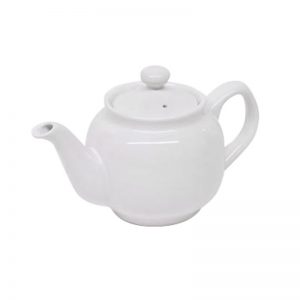 Teacups and Mugs
Teacups and MugsNearly everyone has a favorite cup or mug they like to sip their tea from. Like teapots, there is a seemingly endless array of teacups or mugs available on the market. Some tea drinkers prefer a delicate, antique Chinoiserie teacup and saucer or a treasured bone china set that they grew up looking at in their grandmother’s china cabinet. Still, other tea enthusiasts love to enjoy their tea drinking from a mug made of hand-thrown pottery or one with a favorite slogan that they can warm their hands with on a cold winter day. By keeping the gift recipient’s likes and personality in mind, you can find something truly special that will suit them perfectly.
Giving a tea gift basket this holiday season will make your favorite tea connoisseurs feel both special and pampered. You can find them ready made or you can personally pick out each element that you fill it with to make it truly a one-of-a-kind present that they’ll remember all year long. Why not start with a special teapot, infusers, and teas from Sir Jason Winters International? You can include some of the following tea-centric items in the basket or stocking stuffers
Of course, the most important thing to give to any tea lover this holiday season is the gift of tea itself! Here at Sir Jason Winters International, we have a number of delicious tea varieties. We offer our Classic Blend with either sage or chaparral. Both of these flavors are also available in 20 count tea bags for the convenience of those who are on the go. Additionally, Sir Jason Winters also offers 20 count tea bags in green tea as well as raspberry peach flavored teas.
Whether your gift recipient prefers loose tea, pre-brewed tea or tea bags, they can be assured of the gift of good health this holiday season with a gift from Sir Jason Winter’s teas.
We hope that this list gives you some great ideas for things to give during the next holiday season for the tea lovers in your life!
“The Way of Tea” by Master Lam Kam Chuyen, Lam Kai Sin and Lam Tin Yu, 2002, Barron’s Educational Series, NY
“The Tea Box” by Giles Brochard, 2001, Barron’s Educational Series, Happauge, NY
“The Everything Healthy Tea Book: Discover the Healing Benefits of Tea” by Babette Donaldson, 2014, Everything Publishing, New York, NY
As you might have guessed, here at Sir Jason Winters International, we love tea and are enthusiastic about getting others to experience the goodness that it has to offer. But did you know that tea can also be a fantastic cooking ingredient as well? Tea can add a depth and a unique dimension of flavor to a dish in ways that other ingredients can’t.
Tea can be pre-brewed and used in place of water. It can be infused into chicken stock or added to marinades or used to steam, poach, or used as a key ingredient in stir-fried dishes. Tea leaves added to uncooked rice can be used to smoke as a flavor to meats and fish that are slow roasted in the oven or on the grill. Tea used as a cooking ingredient has even found its way onto programs hosted by celebrity chefs such as Martha Stewart, Steven Raichlen, and Ming Tsai.
If you already love the taste of tea, this article will tell you how you can expand your use of it to create new culinary delights.

If you’re going to use it as a broth, the tea should be prepared in a different way that if you were drinking it. It needs to be much stronger so that the taste comes through the other ingredients. Use cool spring water and allow the loose tea or tea bags to steep for 20 – 30 minutes.
An alternative is to add a teaspoon or two of green or black tea leaves to your soup and let it simmer with all the other ingredients. This will lend a rich, smooth flavor to the entire pot. Traditional healers and doctors in China recommend adding tea to soup to help reduce fat and help make them healthier.
Here are some other suggestions on how to cook with tea from appetizers to main courses to desserts:
Editor of Tea Journey Magazine Cynthia Gold created tea rub that contains tea and 11 spices that can be added to a wide variety of dishes. Combine the following to create this unique spice-rub:
5 tablespoons of finely ground black tea leaves
1/4 light brown sugar, packed
2 tsp ground cinnamon
1 teaspoon curry powder
1 teaspoon ground cumin
1 teaspoon ground red pepper flakes or ground Sichuan peppercorns
1/2 teaspoon cayenne pepper
1 teaspoon freshly ground black pepper
1/2 teaspoon ground star anise or anise seed
1/2 teaspoon ground cloves
1/2 teaspoon ground fennel seed
1/2 teaspoon ground ginger
1/2 teaspoon ground mace
Combine all of the ingredients thoroughly and keep stored in a glass jar. The mixture can be kept either refrigerated or at room temperature approximately two months.
Salmon is a favorite main course dish Celebrity chef, Ming Tsai of Public Broadcasting’s Simply Ming suggests combining the following ingredients to create a marinade for a salmon steak weighing approximately 1 pound that has been divided into fourths.
½ cup mirin
½ cup water
1 tablespoon sugar
1 tablespoon salt
¼ cup julienned ginger
1 teaspoon of toasted Sichuan peppercorns
Combine the mirin, water, sugar, and salt. Add the ginger and toasted peppercorns. Place the salmon in a baking dish and cover with the marinade. Refrigerate in the marinade for 1 to 2 hours.
To create the tea smoking mixture, combine the following:
Line a wok with foil then place the rice, sugar and tea mixture on medium heat. When the mixture begins to smoke or smolder, place in the wok over the top of the rice, sugar and tea mixture.
Remove salmon from the marinade and inside the bamboo steamer. Reduce the heat to low and place wet cloths over the wok and steamer. The salmon should be allowed to steam under the wet cloths for 15 -25 minutes, depending on how well you prefer your salmon to be done.
The host of Project Smoke, Steven Raichlen also uses tea in smoking meats. Raichlen’s recipe of Tea-Smoked Duck has appeared both on his website and the award-winning show.
The duck is washed inside and out and blotted dry. The rub consists of:
1 Tablespoon sugar
1 teaspoon salt
1 teaspoon freshly ground black pepper
½ teaspoon ground coriander
¼ teaspoon ground cinnamon
Thoroughly cover the duck with half of the rub. Take one tablespoon of sesame oil and rub it over the duck. Take the remaining rub and sprinkle over the duck and rub into the skin. Prick the skin of the duck all over with a fork to allow the rub and the juices seep into the meat during cooking.
The following mixture is prepared and used within a meat smoker:
2 cups cherry wood smoking chips
½ cup white rice
½ cup of black tea leaves
½ cup of brown sugar
3 cinnamon sticks
3-star anises
3 strips of tangerine or orange peel
Use half of the smoking mixture in the meat smoker to a temperature of 300 degrees. Cook for approximately two hours. The meat should reach an internal temperature of 145 degrees. Then, increase the temperature of the smoker to 350 degrees; baste with a bit more sesame oil and some of the juices that have gathered in the drip pan that has been placed below the duck. Add the remaining smoking mixture and cook for an additional 1 to 1 ½ hour. The duck should have an internal temperature of 175 -180 degrees or until the skin is crisp and dark. Eat and enjoy the rich spicy and almost grassy flavor of the duck!
These are just a few ideas on how using tea in cooking as an ingredient in a recipe. Try some and see how they turn out or leave us a comment if you have some additional delicious ideas!
“7 Unexpected Ways to Cook with Tea: From Pasta to Pudding”, by Rochelle Billow, Bon Appetit Magazine, https://www.bonappetit.com/test-kitchen/how-to/article/how-to-cook-with-tea
“The Way of Tea” by Master Lam Kam Chuyen, Lam Kai Sin and Lam Tin Yu, 2002, Barron’s Educational Series, NY
“Cooking With Green Tea” by Ying Chang Compestine, 2000, Avery Publishing, Garden City, NY
“The Story of Tea: A Cultural History and Drinking Guide” by Mary Lou Heiss, 2007, Ten Speed Press
“The Book of Green Tea” by Diana Rosen, 1994, Storey Books, Pownal, VT
“Martha Bakes: Green Tea Episode”, Martha Stewart, broadcast, PBS, November 18, 2015, (http://www.pbs.org/food/features/martha-bakes-green-tea-episode/ )
As colder weather is now on the horizon, so is cold and flu season. Coming down with a cold or flu can put you out of commission for a few days to a couple of weeks – or it can linger for even longer if you don’t allow yourself adequate rest and recovery time.
The good news is that there are ways that you can boost your body’s own natural immune system in order to stay well. Your immune system is your first line of defense against colds, flu and other illnesses, including cancer.
Of course, here at Sir Jason Winters International, we do recommend that you listen to your doctor if he/she suggests getting your yearly flu shot as a first defense. But there are other things you can do to help prop up your immune system with herbal teas. Here’s what you need to know to help defend yourself against cold and flu this season.

Winter often brings stresses that lower the body’s natural defenses and vitality, but herbal teas can help with this. When you start to feel as if you may be coming down with something, a bit of hot herbal tea along with a bit of lemon and honey can be just what the doctor ordered. Hot liquids can help relax you, ease sore and aching muscles and warm you on the inside.
Here are some of the ways that you can use the power of tea to help boost your immune system during the cold winter months or any time of the year.
One wonderful way to do this is by drinking and enjoying tea every day.
Since ancient times, both green and black tea (Camellia sinensis) has been used within the healing system of Traditional Chinese Medicine (TCM) and Ayurveda from India. Green tea is an overall good health as a tonic for the heart, digestive tract and can lower incidence of diabetes and liver disease. Modern researchers have also found that there is evidence that it may even help the body to resist some forms of cancer through its strong antioxidant properties. These antioxidant compounds, also known as polyphenols, are found to be at their highest concentrations within green tea.
Traditionally, this herb has been used around the world as an excellent beverage for those suffering from colds or flu. Red clover is one of the chief ingredients that Sir Jason Winters himself found that helped in his own recovery from cancer and it is included in our Sir Jason Winters herbal formulas. Red clover, known by its botanical name of Trifolium pratense, can reduce inflammation in the body, help the body to effectively eliminate toxins, assist heart and lung function and has to trace antibiotic properties.
Used by indigenous tribes in the Southwest United States and throughout Mexico, Chaparral (Larrea tridentata) has shown itself to be effective in addressing colds, flu, and respiratory infection. Also known as Creosote Bush, chaparral is an excellent blood purifier and has pain relieving properties that can help when you ache all over. Sir Jason Winters found that chaparral was instrumental in treating his own illnesses. This herb has been included in Sir Jason Winters Classic Herbal Tea with Chaparral.
Cinnamon is another herb that has a long history of being used as a means to treat colds and flu. In 2012, the Journal of Traditional and Complementary Medicine released a report citing cinnamon, known as ròu guì in traditional Chinese medicine, as being one of the most important herbs. It is considered an antioxidant, antiviral, antifungal, and is known to lower cholesterol through its tonifying and warming properties. We understand the goodness of cinnamon and have included it in our in our Sir Jason Winters’ Pre-Brewed Tea with Cinnamon and Stevia in loose leaf form so you can enjoy it any time you wish!
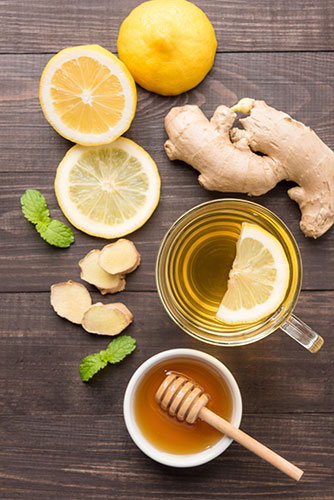
Like many other herbs from the East, slicing a bit of ginger (Zingiber officinale) and brewing it with your tea. Whenever you are suffering from a bout of nausea, stomach upset or indigestion, ginger is one of the most effective herbs you will find. Ginger has anti-inflammatory, antibacterial, antiviral and cough suppressing properties. It can also help to induce sweating – so if you are suffering from a fever, ginger may be a way to help you to break it.
The Ancient Egyptians knew of the wonderful healing properties of pure raw honey. When you brew your cup of tea and sweeten it to taste with honey, you are taking advantage of its antioxidant, antiviral properties to fight against what ails you. Honey has a unique way of easing sore throat pain and will boost your immune system and reduce the severity of cold or flu.
You can make a gargling solution of green tea and honey to ease sore throat pain. Brew your cup of tea as you normally would and add a teaspoon of honey to the tea. Allow it to cool to room temperature then gargle with it as needed.
Many tea drinkers of Sir Jason Winters’ teas enjoy regularly adding both lemon and honey to their tea. This doesn’t just make them tastier, but can help improve the potential health benefits of the tea. As cold and flu season comes on us, stock up on some of the teas we’ve mentioned and made them part of your routine. You just might dodge the flu bullet.
“The Family Herbal: A Guide to Living Life with Energy, Health and Vitality” by Rosemary Gladstar, 2001, Storey Books, Pownal, VT
“School of Natural Healing” by Dr. John R. Christopher, 20th Anniversary Edition, 1996, Christopher Publications, Springville, Utah
“The New Age Herbalist” by Richard Mabey, 1988 Gaia Books, Ltd. London
“The Book of Herbal Wisdom: Using Plants as Medicine” by Matthew Wood, 1997, North Atlantic Books, Berkley, California
“In China, Your Grace, there is not a single plant that can compare to Ginseng.” — Father Joseph-François Lafitau, scholar & Jesuit missionary, Paris, 1718
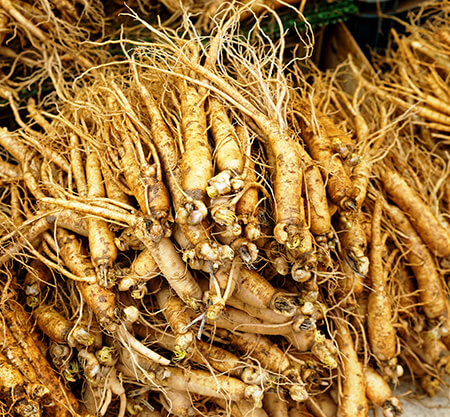
The parts of the herb that is used are the roots and the leaves of the plant. The plant grows mainly in forested areas and grows to about one foot in height. The leaves die off each year and the root continues to grow.
The age of a ginseng plant can be told by the number of rings on the neck of the root. According to Traditional Chinese Medicine, the energy of ginseng is sweet, slightly bitter and warming. It affects the spleen, lungs and heart systems as interpreted in this system. It is stimulating in nature and has a long earned reputation for being a rejuvenator of the body.
Herbal Actions – Ginseng is said to have both calming and stimulating constituents within it. Traditionally, herbalists have found that ginseng can be calming, enhance mental clarity, stimulate the nerves and yet instill a sense of well-being. Because of these actions, ginseng is considered an adaptogen. An adaptogenic herb assists the body so that it can more easily adapt to stress, raise energy levels and boost immunity.
Another wonderful effect of ginseng for men is that it can help to stimulate the libido. Sir Jason Winters International utilizes the natural goodness of ginseng in our Golden Lion Supplement, which we have specially formulated for men. This formula was named after an ancient legend from India and China. The people called him “the Golden Lion” because this herbalist and teacher healed and taught many in the villages that he visited, fathered many children, and was vigorous, healthy and strong well into his advanced years.
Treasure of the Emperors
Throughout ancient China’s long dynastic history, Emperors were said to have paid as much as their weight in gold in order to possess the finest and oldest ginseng root. These rulers believed that ginseng would give them wisdom and safeguard their dynasties by ensuring a long and healthy life. Because of this, ginseng’s reputation has endured throughout the world for centuries.
In traditional Chinese medicine (TCM) and within Ayurvedic medicine of India and Unani medicine in Arabia and the Middle East, ginseng has been long considered an invigorating tonic and thought to be one of the greatest secrets for a long life. Perhaps this is because ginseng is especially helpful in improving the body’s ability to cope with stress, fatigue, lack of sleep and extremes in temperature, ginseng is taken by those who have weakened immune systems and the elderly in northern and Central China from middle age onward.
Ginseng’s worldwide reputation was so great during the late 17th and early 18th century that wars were even waged to control the forests in the new world where it grew.
There are a variety of plants worldwide that have been considered forms of ginseng. Below are some examples.
Researchers have recently shown that the substance within ginseng known as ginsenosides. These substances within the various kinds of ginseng have shown an ability to potentially reduce the development of certain types of cancer. These ginsenosides have been shown to stop blood vessels from forming tumors and assists in eliminating the production of these types of abnormal cells within the body that can cause cancer to spread.
As you can see, all of the different ginsengs have a reputation that is well-deserved. As with any herbal supplement, if you are considering giving ginseng a try it’s important to discuss it with your doctor or a trained herbalist first.
“Planetary Herbology “ by Michael Tierra, C.A., N.D., 1988, Lotus Press, Twin Lakes, WI
“The Encyclopedia of Medicinal Plants” by Andrew Chevallier, 1996, Dorling Kindersley Limited, London
“The Complete Writings of Dr. John R. Christopher “ (http://online.snh.cc/files/2100/HTML/100hs_ginseng__panax_quinquefolius.htm ), web.
One of the chief ingredients of Sir Jason Winters teas is red clover (Trifolium pratense). In spite of how ordinary it seems to be because you might see it almost every day either growing in your yard or growing along the roadside, it may be surprising to learn that it is considered an especially powerful blood purifier and detoxification herb. Red clover tea tastes delicious, so much so that you might even be tempted to overlook the value of this very common plant.
This herb is part of the legume or bean family and can grow almost anywhere in the world. Though it was not originally native to the United States, today it grows profusely, especially in the plains states. It is often found along roadsides and is also commonly used as a choice grazing crop for livestock. Cattle feed during the winter months usually uses red clover for nutrition.
Unlike the common white clover you can find in lawns and parks, red clover is a perennial plant that grows one to two feet in height. The rootstock is short and produces green to reddish-green hairy stems and pink to purple egg-shaped flowering tops. This three-leafed plant flowers in early to mid-summer when the weather is cooler and then blooms once again in the early fall. The flower heads are gathered from May through September. This is the part most often used for tea through the leaves and stems can also be used. The reddish flowers of red clover have a slightly sweet taste and can be eaten fresh right off of the plant during long walks or on lazy early summer afternoons.
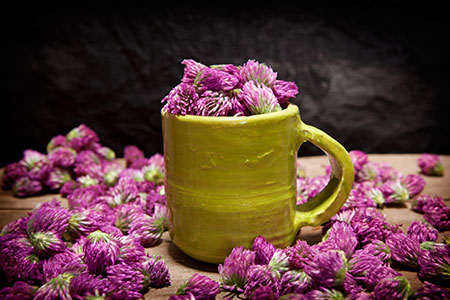
One of the first places Sir Jason Winters looked in the various holy texts from around the world. The first one he examined was the Bible. Sir Jason found that the Bible made reference to an herb. But which one could it be that was mentioned no fewer than 27 times within the text? Curious as to what this herb might be, Sir Jason wrote to the Archbishop of Canterbury to see if he might have an answer. After some investigation of his own notes, the Archbishop believed that the herb Sir Jason Winters was looking for was none other than red clover.
Through his correspondence with the Archbishop and his own reading and research, Sir Jason Winters determined that even in ancient times, red clover was traditionally used as a blood cleanser and tonifier. Indeed, the early Twentieth Century herbalist and author of Back To Eden, Jethro Kloss, said that “Red Clover is one of God’s greatest blessings to man.” In medieval England, the groups of three leaves on the plant were associated with the Trinity.
According to American Herbalist Guild (AHG) recognized professional herbalist and naturopathic doctor, Michael Tierra, red clover is often used on its own and has a direct effect on the liver, and works to assist the body’s lymphatic system so that toxins can be eliminated from the body.
Researchers at the University of Utah have found that red clover can assist the heart and lungs as well as having some estrogenic properties that can help women. This is attributed to the coumerol, a phytoestrogen which is found mainly within the flowering tops of red clover. This plant also contains flavonoids, phenolic acids, such as salicylic acid.
There have been additional studies conducted which have also shown that red clover contains some antibiotic properties, particularly the pathogen which is directly connected to tuberculosis.
Along with all of the things that have caused red clover to be fully embraced for the last 100 years as a healthy addition to the diet, it has also been noted that there may be some constituents contained within red clover which have shown to arrest the growth of certain types of growths, or lumps beneath the skin. Other traditional uses for red clover have included:
Red clover contains Vitamin A, B-complex, B-12, and Vitamin C. The plant also contains calcium, copper, iron, magnesium, manganese, potassium, selenium, nickel and fatty acids.
While red clover appears to act the lymphatic system which acts as a purifier for the liver and the bloodstream, it is antiseptic in nature and is excellent for mothers who are nursing. It is a nerve soother and slightly sedative in nature.
Along with all of these great benefits, red clover is what is considered a food herb. Herbs which are classified as food can generally be consumed anytime you wish. That means you can enjoy your cup of Sir Jason Winters tea containing red clover whenever you like, sit back, relax and enjoy!
As with anything, here at Sir Jason Winters International, we believe that it is always a good idea to discuss any herbs and supplements that you consume with your physician.
Resources
“The Encyclopedia of Medicinal Plants” by Andrew Chevallier, 1996, Dorling Kindersley Limited, London
“School of Natural Healing” by Dr. John R. Christopher, 20thAnniversary Edition, 1996, Christopher Publications, Springville, UT
“The Complete Writings of Dr. John R. Christopher”, (http://online.snh.cc/files/2100/HTML/100hs_red_clover__trifolium_pratense.htm ) web.
“Back To Eden” by Jethro Kloss, (Complete Kloss Family Edition) 1939, Woodbridge Press, Santa Barbara, CA
“The Herb Book” by John Lust, 1978, Bantam Books, New York, NY
“Herbal Medicinals: A Clinicians Guide”, Lucinda G. Miller, PharmaD, BCPS, and Wallace J. Murray, editors. 1998, Pharmaceutical Products Press, Binghamton, NY
“Planetary Herbology” by Michael Tierra, C.A., N.D., 1988, Lotus Press, Twin Lakes, WI
“The Book of Herbal Wisdom: Using Plants as Medicine” by Matthew Wood, 1997, North Atlantic Books, Berkley, California
Everyone is interested in improving their overall health and strengthening their natural immunity. Our immune system helps us to fight off infection, colds, flu, helps to ward off fatigue and inflammation, and can help the body repair injuries.
Ask anyone their opinion about what would be the best prescription for staying healthy and they will recommend that it means eating a balanced diet consisting of good, nutritious food, keeping away from deep fat fried or sugary foods, avoiding smoking, consuming alcohol only in moderation, getting plenty of exercise and plenty of good, restful sleep.
In addition, the use of herbal teas as a way to help maintain and to fortify a healthy balance in the body and boost your immune system. Each of these things working together can strengthen the systems with the body so that it can more readily fend off colds and other illnesses. Of course, it is always a good idea to consult with your doctor if you plan to use herbal tea to help boost your immune system.

When Sir Jason Winters was told by doctors that he was seriously ill with terminal cancer, he was determined to find a more natural way to help himself. Even though doctors told him that he probably had very little time to live and he and his family had little money, he traveled around the globe to find an alternative method that might help him regain his strength and possibly increase his chance of survival. He discovered in reading various religious texts from around the world that herbs were referred to as a way to treat the body. In the Bible, herbs were referred to at least 27 times! Sir Jason believed through the bounty of nature’s herbs that he may have found the answer he was looking for.
Three Herbs from Around the World
One of the chief ingredients of Sir Jason Winters teas is Red Clover (Trifolium pratense). Sir Jason, through his communication with the Archbishop of Canterbury determined that even in ancient times, this herb was traditionally used as a blood cleanser and tonifier. Red Clover works to assist the body’s lymphatic system so that toxins can be eliminated from the body.
One of the other key ingredients in Sir Jason Winters teas, Sir Jason learned about through the religious and healing texts of the Buddhists. Buddha himself had told his followers in India more than 2500 years ago about an herb that grows in Singapore. Historically this herb, which is part of our proprietary Herbalene Blend, has been used by doctors and healers of India and Asia as an herb that helps the body to fight against illnesses such as cancer. Herbalene is included in our original chaparral and sage blend of teas and is exclusive to Sir Jason Winters teas.
When Sir Jason Winters worked with Native American actors on Hollywood movie sets, he learned about the third amazing herb. The Native actors told Sir Jason about how Indigenous people of the U.S. Southwest and Mexico used Chaparral (Larrea tridentata) and sage (Salvia Officianlis) for several thousand years as a tea so that they could purify the blood and flush the body of toxins. Studies conducted by the University of Utah found that when used in moderation, it did provide many antioxidant properties to help the body fight cancer.

Many herbs are able to work very well on their own. Teas which are made from using a single herb are referred to as an herbal ‘simple’. Simples can provide a very gentle form of helping the body help itself. When facing his own health challenges, Sir Jason Winters became convinced of the power of each of these three herbs. Initially he tried the method of using the herbs as simples, but found that there was not much effect when he drank just one at a time.
One day, Sir Jason decided to combine them all together as a single blended tea. When he did, he felt much better in a short amount of time. Because it made him feel better, he kept on using all three herbs as a tea blend.
Blending teas allowed Sir Jason to take advantage of the powerful properties of each herb, the mix enhancing the effect. He realized that it had been the mixture of the herbs that had assisted his own body in rebuilding its own natural immunity.
At the end of doing this for nine weeks, Sir Jason Winters returned to his doctors once again. This time they were all amazed that he was doing so well. When the doctors asked him what he had been doing, they asked Sir Jason if they could analyze his tea blend. The doctors were amazed that these herbs had potentially helped Sir Jason. Whatever he had been doing, the doctors urged him to continue doing because he was certainly much better since they had last seen him!
Delicious, Healthful Formulas
Blending and formulation is considered both an art and a science. Used together, herbs can help boost our body’s own natural systems in a non-invasive way. This is especially true of food herbs like the ones which appear in Sir Jason Winters Teas.
Many herbal teas, including those made by Sir Jason Winters International, are carefully blended together and formulated so that each herb works together with the other herbs within the formula and tastes good, too!
Any type of health regimen should be discussed with a doctor. Many people have found, however, that regularly consuming herbal tea along with eating a healthy diet, getting plenty of exercise, a good night’s sleep and by practicing other healthy habits, goes a long way in helping to boost the immune system within the body. Having that strong immune system enables the body to ward off illnesses on its own far more easily and will lend an overall sense of good health and well-being.
Resources
“The Encyclopedia of Medicinal Plants” by Andrew Chevallier, 1996, Dorling Kindersley Limited, London
“School of Natural Healing” by Dr. John R. Christopher, 20thAnniversary Edition, 1996, Christopher Publications, Springville, UT
“The Family Herbal: A Guide to Living Life with Energy, Health and Vitality” by Rosemary Gladstar, 2001, Storey Publishing, North Adams, MA
“Herbal Medicinals: A Clinicians Guide”, Lucinda G. Miller, PharmaD, BCPS, and Wallace J. Murray, editors. 1998, Pharmaceutical Products Press, Binghamton, NY
“Planetary Herbology”by Michael Tierra, C.A., N.D., 1988, Lotus Press, Twin Lakes, WI
“The Book of Herbal Wisdom: Using Plants as Medicine” by Matthew Wood, 1997, North Atlantic Books, Berkley, California
For centuries, mankind has used herbs to help lead a healthy lifestyle. Here at Sir Jason Winters International, we pride ourselves on offering only the very best quality herbal and green teas. How do you take our products and turn them into the perfect cup of tea? Here’s what we recommend.
Which Tea is Best?
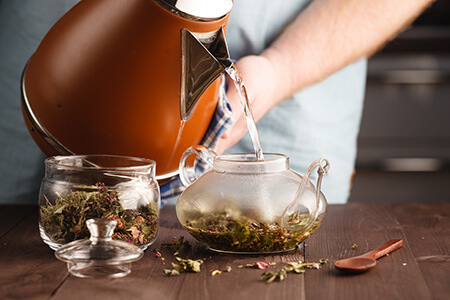
Tools of the Trade
The most important ingredient in brewing the perfect cup of tea is the actual tea. Good tea starts with good ingredients. By purchasing the best tea and herbs from a reputable company like Sir Jason Winters Teas, you are already halfway to an excellent cup of tea!
Our teas are blended to take full advantage of the taste and properties of the herbs. Our chaparral and sage 5 oz tea are naturally caffeine free.
Water
Tea experts and enthusiasts have differing opinions on the best type of water to use when making a proper cup or pot of tea. Almost everyone agrees that the most important thing is to have the purest water that is available. For many people, taking water straight from the tap is just fine. For others, because there are growing world-wide concerns over water quality and safety, filtered water is the preference for brewing tea. Also, Alkaline water is a very good choice as well.
Additives can make a difference in flavor, particularly if the water is chlorinated or very hard with mineral deposits. Surprisingly, distilled water can make your tea taste dull.
It is best to use freshly drawn, cool water and bring it to a gentle boil. Care must be taken not to let it stay at a rolling boil for too long to avoid making the water taste flat or lifeless. Once your water reaches temperature, you may add the loose leaf or pour it over tea bag.
Tea Kettle
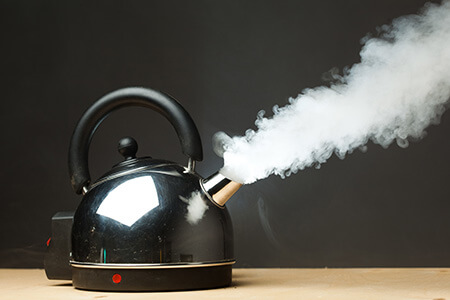
How much you heat the water in the tea kettle depends upon the kind of tea you are brewing. While some teas need boiling water, others need to be hot, but not boiling. Below are the rules of thumb for each type of tea. For this, you may need a thermometer in order to get the temperature just right.
Tea Tools
Once the water is brought to a boil, the tea is then infused in a separate vessel such as a teapot or cup. Many teapots have built-in infuser baskets or a tea ball to make removing the tea leaves easier. Other approaches include placing the tea and water directly into the pot to steep, then pouring the infused tea through a strainer to catch the tea leaves. A tea infuser can fit over the rim of the cup and can hold the heat inside the cup and aid its infusion. You may also choose to use a small reusable muslin bag. Or, if you’re using a bagged tea, just pop it into your cup and pour your water over it.
How to Store Your Tea
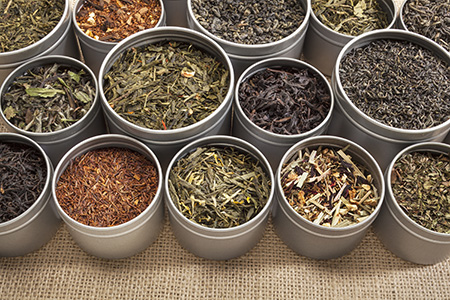
Is it Tea Yet?
Tea is all about relaxation and enjoyment. Admittedly, waiting for the tea to steep really can be the most difficult part! For our loose leaf teas, place the desired amount of tea within a tea ball or tea sack for about 15 minutes.
Our herbal tea bags don’t need to be steeped nearly as long thanks to our manufacturing process. You can enjoy a cup of Sir Jason Winters Original formula tea in just a couple of minutes or as long as you wish. Each tea bag in a box of 20 or 30 can make up to three cups of tea.
Our pre-brewed original formula loose leaf teas are also able to be ready in just two minutes, as can our pre-brewed green tea or GHT. Simply take ½ teaspoon of our pre-brewed tea and allow it to steep for approximately two minutes and you will have a perfect cup of tea in almost no time!
Whether you prefer our loose leaf, bagged or pre-brewed options, each has been perfectly formulated to give you great flavor and all of the benefits you’ve come to expect from Sir Jason Winters Teas.
Resources
“The Way of Tea” by Master Lam Kam Chuyen, Lam Kai Sin and Lam Tin Yu, 2002, Barron’s Educational Series, NY
“The Tea Box” by Giles Brochard, 2001, Barron’s Educational Series, Happauge, NY
“20,000 Secrets of Tea”by Victoria Zak, 1999, Random House, New York, N.Y.
“Starting Out in Herbalism” by Christina Paul, Real World Homesteading blog (https://realworldhomesteading.com/2018/02/17/starting-out-herbalism/)
A Message from the Author:
I dedicate my writings to love… to life… and the pursuit of happiness – joy and struggles, triumphs, even tragedies that go along the with this brilliant journey.
“If your heart is troubled, I hope for tranquility in your life… if your struggles are hard to bare… I pray for patience. And if you’re in the middle of it.. don’t lose your way…
There is always light at the end of the tunnel Your life is going to be epic.”
Written by Sir Raymond Winters
My philosophy is quite simple… First, I will do no harm to anyone, and I hope no one does harm to me.
I think we need kindness, forgiveness and joy in our lives.
Kindness should never be confused for weakness.
Kindness – love – compassion – understanding – affirmation; these are the best qualities in humans. We all are capable of being kind and showing kindness in our lives. Just try it.
Also available for digital download
